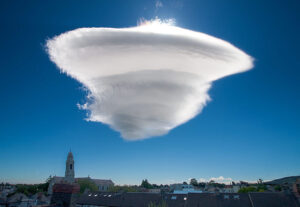Legend and Myth alike we all have heard about the Cumulonimbus clouds, their awe inspiring presence brings the promice of storms, and clean air too.
“When thunder roars, go indoors!” That’s the golden rule when you spot the king of clouds—the mighty cumulonimbus. These celestial skyscrapers are more than just fluffy formations; they’re the architects of storms, the conductors of lightning, and the bearers of rain. Buckle up—we’re about to explore the heights and depths of these atmospheric titans.
1. Anatomy of a Cumulonimbus Cloud
The Base
- Picture a massive cauliflower, its base stretching across the sky. That’s the cumulonimbus. Its roots? Usually below 2 kilometers (6,500 feet) above ground level.
- These clouds form when warm, moist air rises, cools, and condenses. The result? A dense, towering vertical cloud that defies gravity.
The Towering Top
- Cumulonimbus clouds don’t settle for mediocrity. Their tops often reach higher than 10 kilometers (35,000 feet). Imagine a skyscraper party where the penthouse touches the stratosphere.
- Normal peaks? Around 12,000 meters (39,000 feet). Unusually high ones? Up to 20,000 meters (66,000 feet). Extreme instances? Claimed to be as high as 21,000 meters (69,000 feet) or more. These clouds play altitude limbo like pros.
The Anvil Dome
- Well-developed cumulonimbus clouds flaunt an anvil-shaped top. It’s like Mother Nature’s architectural masterpiece. Wind shear or inversion near the tropopause sculpts this icy shelf.
- Lightning dances along the anvil’s edge, throwing a celestial soirée.
2. Cumulonimbus in Action
Thunderheads and Storms
- When cumulonimbus clouds cause thunderstorms, they earn the nickname “thunderheads.” These aren’t your run-of-the-mill afternoon showers; they’re meteorological rock concerts.
- Lightning crackles, hailstones tumble, and rain pours like a monsoon. Tornadoes might even crash the party.
Three Stages of Cumulonimbus
- Developing Stage: Innocent-looking cumulus clouds grow into cumulonimbus. The air inside rises, cools, and condenses. The party begins.
- Mature Stage: The main cloud reaches supercell status (think storm on steroids). The average thunderstorm spans 24 kilometers (15 miles) and reaches heights of approximately 12.2 kilometers (40,000 feet).
- Dissipation Stage: The storm exhausts itself, rain falls, and the cumulonimbus retreats. The afterparty cleanup begins.
3. The King’s Legacy
- Cumulonimbus clouds are the ultimate storytellers. They narrate tales of lightning bolts, torrential downpours, and wind gusts that rearrange landscapes.
- So next time you see those anvil-shaped giants, tip your hat to the sky. Cumulonimbus clouds are the architects of drama, the maestros of weather symphonies.
Remember, when cumulonimbus clouds gather, it’s not just rain—it’s a celestial opera. And as the saying goes, “When thunder roars, go indoors!” 🌩️🏰🌧️
Learn more about the skies and their secrets:
Whether you’re a weather enthusiast or just a cloud-watcher, cumulonimbus clouds deserve a standing ovation. If you have more sky-high questions, feel free to ask—I’m here to unravel the mysteries of our celestial theater! 🌟☁️🔭
For more cloud based information go back to the previous page here or back to the main site here
Tell us how can we improve this post?
Hi I am Marcus, MM0ZIF, a licenced Radio Amateur, Doctor of Musicology, amateur weather enthusiast. I over the years have been a Amateur Radio Tutor, Examiner, and a Regional Manager for the Radio Society of Great Britain.
This site is dedicated more towards Amateur Radio and Weather, with an angle on Technology too. I also maintain https://havenswell.com/ which is my other blog which is more aimed at cooking, hobbies and life in general as well as businness and networking.










